[Updated February 2024]
Key Takeaways
Below is a table of the top Social Media Monitoring Tools and software. Click here to read more below.
| Platform | Key Features |
|---|---|
| All Ears | All Ears focuses on audio and video social listening, analyzing content across platforms like TikTok, YouTube, and Podcasts using AI for transcription, sentiment analysis, and real-time alerts. |
| Talkwalker | Social listening tool with a built-in, ready-to-use social media command center. Combines machine learning and human insights to extract actionable insights from social media content and other platforms. |
| Brandwatch | Tracks, analyzes and understands social media conversations. Provides insights into brand mentions, sources, mention volume, and demographic data. Offers sentiment analysis and competitive intelligence. |
| YouScan | Excels in image recognition capabilities. Provides audience insights and evaluates sponsorship activities by analyzing branded social media posts, mentions, and user-generated content. |
| Synthesio | Provides social listening dashboards and social media command centers for data visualizations and monitoring of real-time trends, events, and conversations. Offers audience management feature and Topic Modeling. |
| Pulsar | Offers four parts of its social listening software–TRENDS, TRAC, CORE, and RESEARCH. Provides data visualization of social media trends, advanced social listening with keyword, content tracking, and audience segmentation. |
| Digimind | Integrates Facebook, Instagram, and LinkedIn post-level data. Uses AI-enabled social listening technology for tagging sentiment analysis and visual listening. Provides multiple ways to visualize and export reports. |
| Infegy | Advanced social media listening tool led by text analytics and natural language processing (NLP). It provides multiple ways to analyze text data, sentiment, emotions, volume, reach, and engagement. |
| Netbase | Enterprise-level social media monitoring tool. Provides insights from content posted on all digital channels. Offers advanced Natural Language Processing (NLP) engine, image monitoring, trend tracking, influencer engagement, and real-time insights. |
| Zignal | Detects and assesses topics and narratives. Known for helping brand managers and PR pros navigate crises on social media and within media coverage. |
| Linkfluence | Provides industry and brand insights. Mines data from across the web to capture real-time social media and forums conversations. Provides advanced analytics and social media listening tools like sentiment analysis, trend discovery, and audience profiling. |
Brief Background of the Social Monitoring Landscape
The social media monitoring landscape has always been crowded. While the market continues to mature and innovate, tracking who comes, who goes, which social listening tools merge, and which ones get acquired is challenging.
Suppose you are in the market to invest in social media monitoring software. In that case, I have started curating a list of the leading social monitoring tools I have used in the past, which may help with your purchase decision. Likewise, if you are interested in PR and media software, I’ve provided a similar analysis of the media monitoring tools.
History of Social Media Monitoring Companies
In the beginning, there was the World Wide Web. Eventually, this became the Internet. And the Internet soon transformed into something more two-way and dynamic, becoming social media. The democratization of publishing content online followed, which created an open and public dialogue that consumers had about every product, service, and topic you could think of. Brands needed to start paying attention because many social media conversations involved their products, services, and executives. So, over the years, monitoring social media for brand mentions and real-time audience insights became a marketing strategy.
A few social media monitoring companies dominated the space in the early days. Larger software companies have acquired all of them:
| Vendor | Acquired by | Acquisition Details |
|---|---|---|
| Radian 6 | Salesforce | Salesforce acquired Radian6 in 2011 for approximately $326 million in cash and $50 million in stock. Radian6’s technology is now part of the Salesforce Marketing Cloud. |
| Sysomos | Meltwater | Sysomos was acquired by Meltwater in April 2018. The CEO of Sysomos, Peter Heffring, said the company would continue to operate as an independent unit of Meltwater. Heffring would run the social analytics division of Meltwater. |
| Collective Intellect | Oracle | Oracle acquired Collective Intellect in June 2012. The acquisition was intended to add real-time social monitoring, analytics, and insights to Oracle’s social platform. The terms of the agreement were not disclosed. |
| Visible Technologies | Cision | Visible Technologies was sold to Vocus and Cision, a newly-merged company that makes software for the public relations field. The terms of the deal were not disclosed. |
| Cymfony | Visible Technologies | Cymfony was merged with Visible Technologies in 2012. The specific financial details of the acquisition were not disclosed. |
| Scout Labs | Lithium Technologies | Visible Technologies was sold to Vocus and Cision, a newly merged company that makes software for the public relations field. The terms of the deal were not disclosed. |
Radian 6 and Sysomos were the best social media tracking tools then. While these early social media monitoring companies have paved the way for new product innovation, there are new vendors today that have differentiated functionality and pricing options.
What is Social Media Monitoring?
Social media monitoring is the marketing practice of using software to track conversations and mentions on social media. Other use cases include measuring share of voice, social analytics, reporting & measurement, and managing social customer care. Most social media listening software tools track brand mentions across all platforms, news sites, reviews, and blogs.
A few platforms provide advanced analytics, NLP, and text analysis, taking social listening to the next level. It goes beyond measure in numbers and provides the context of social media conversations.
How Does Social Listening Software Work?
All social listening platforms work the same way. You start with identifying the most relevant keywords to your products, services, and business. This includes brand-specific keywords as well as topical or industry-related keywords. Once you’ve identified the right keywords, you add them to the social media listening platform using a form of Boolean Logic.
You then have to decide which channels you want to monitor and from which channels. This will include news, review sites, blogs, and social media channels. Other than LinkedIn and Facebook, the platforms supported include most other social networks. More advanced social monitoring platforms provide audience research and the ability to listen to social media mentions over time.
The social monitoring tool collects mentions from each source and then displays them using various data visualizations. You can then use the data and look for actionable business insights. Based on my research, it’s clear that some social media monitoring tools prioritize data visualization and data mining over others.
Most social listening features include access to historical data from various online sources dating back 10+ years, allowing you to track industry trends or consumer conversations over an extended period.
Also, sentiment analysis is a common feature among social media monitoring tools. Sentiment analysis is about 60% to 65% accurate without human layer analysis. If you are not cross-referencing sentiment analysis and manually coding data samples, you might get sentiment analysis completely wrong.
Most social media scanning tools don’t advertise that they have free trials. However, if you are an active buyer and have gone through a series of demos but are still unsure, most platforms will honor free trials with limited access to data.
Regarding advanced reporting capabilities, only a few social media monitoring platforms have distanced themselves from the rest of the pack. For example, Digimind provides advanced API access and directly integrates with Google Data Studio. This is where most social platforms can innovate and provide better access to advanced reporting capabilities.
Advanced Use Cases of Social Media Monitoring
My favorite social media monitoring use cases are real-time audience listening and customer engagement. This involves building specific audiences important to your business, listening to what they publish online, and sharing and talking about it in real time. It’s also using the data to create content relevant to those conversations. This approach will foster brand advocacy and support a data-driven customer engagement strategy.
Another use case of social media monitoring is listening to customer feedback, consolidating insights, and taking action. For example, customer feedback might show that your audience is asking for a particular color of sneakers or a new feature added to your software. Taking action means implementing that customer feedback into your product roadmap. This drives product innovation, and it can also create brand ambassadors at the same time.
I use two additional use cases with social media monitoring tools that I probably talk about too much— audience analysis and media intelligence.
Using the features and functionality of social media listening, it’s not difficult to analyze audiences to understand better who they are and what they care about. From a B2B standpoint, imagine tracking IT decision-makers and their conversations on social media throughout their buyer journey. It’s possible.
You can do the same with various consumer audiences like Gen Z. We all know they are very vocal online and are not shy about telling the world what they like and dislike when buying products. So imagine tracking Gen Z’s shopping habits for different products and services. It’s possible.
I also prefer to use social media monitoring tools to analyze specific headlines and long-form coverage in the media by using text analysis. This approach can uncover hidden narratives the media is writing about and make your narrative more relevant when pitching to reporters. This type of analysis is critical to any PR strategy.
Building an Integrated Social Media Listening Strategy
Most people equate social media monitoring with just social media marketing. For years, social media as a marketing practice was just an add-on to someone’s responsibilities. This person could have worked in public relations, marketing, or customer support. It wasn’t until about seven or eight years ago that CMOs and marketing leaders began to create teams specifically for social media.
These teams comprised social media managers, creative designers, analysts, copywriters, and paid media strategists. Since the social media job function has become a much more strategic force supporting almost all businesses, it has achieved its independence as a stand-alone team and role.

All that to say, social media monitoring is much more than just a tool for community managers. Analyzing online conversations can provide consumer insights about products, features, competitors, etc. However, it’s up to marketing and public relations teams to mine these conversations and extract relevant insights for their business. Integrating social listening tools with other relevant data like web analytics, social media analytics, and primary research becomes even more strategic and business-critical.
As mentioned above, insights extracted from social media monitoring can inform marketing, PR, customer support, sales, and product innovation. It can also provide supplemental data for market research teams and be a core representative data set to monitor brand health online.
Differences Between Social Listening and Social Monitoring
This is more about semantics, but social listening and monitoring mean the same thing. The definition of monitoring is to “observe and check the progress or quality of (something) over a date range.” In this case, “something” refers to social media and the conversations happening online and on various digital channels.
However, social media monitoring software is another category for your martech stack. While they do have social media monitoring capabilities, the core value proposition of this type of software is more about publishing, scale, and governance.
There is more than just social listening if you think about the roles and responsibilities of social media marketing as a job function. You must consider publishing posts, customer engagement, password management, integrated analytics, and social care. Unfortunately, the social media monitoring platforms listed below don’t offer all these other capabilities. Two software media monitoring companies that provide this are considered leaders in space, Sprinklr and Khoros (formerly Spredfast).
The Analyst’s Perspective: Social Media Monitoring Tools
Sadly, large analyst firms like Forrester and Gartner don’t prioritize the social media monitoring industry. There have been reports in the past, but they’re not as frequent or comprehensive as they should be. This is one reason you should look beyond the analyst reports when investing in social media monitoring tools.
The Forrester Wave Report in 2020 did highlight the top social listening platforms. Unfortunately, not all vendors made it into the report, but they all have features and functionality worthy of enterprise deployment and consideration.
Below is the Forrester Social Wave report and the G2 Grid for Social Analytics. For reference, the G2 Grid is peer-reviewed and has similar data points to Forrester, specifically around the market presence of social media monitoring companies.
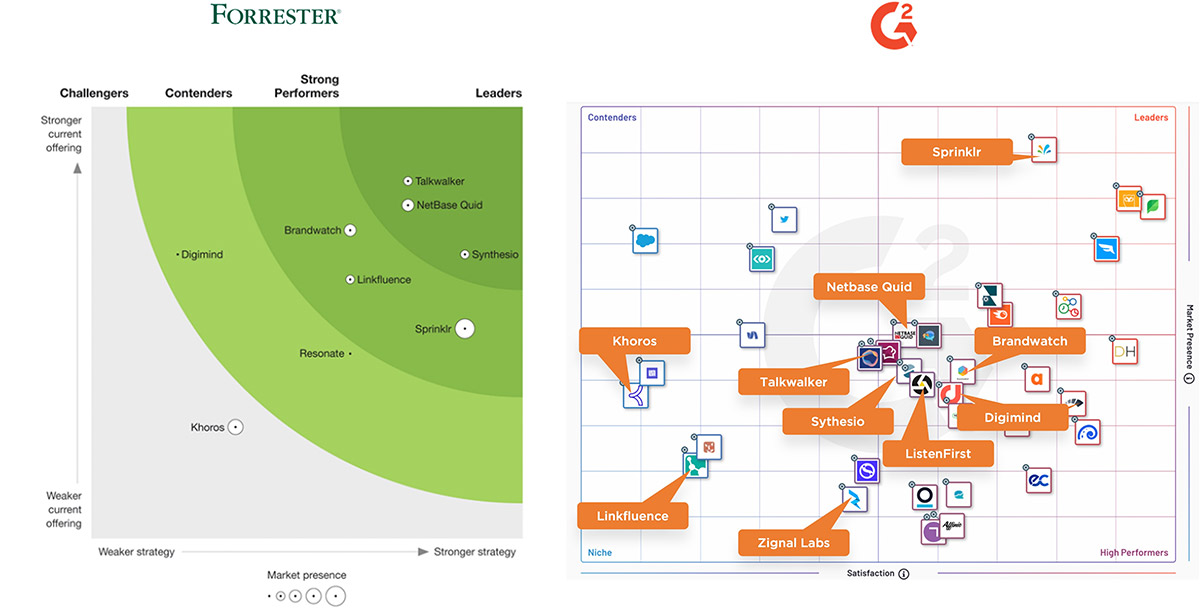
Mostly, there is little differentiation between the social media monitoring tools in the market today. However, the functionality differences, scalability, and cost might attract different buyers to these social monitoring platforms based on business and technical requirements.
The Top Social Media Monitoring Tools & Software Platforms
Below is a curated social media monitoring software comparison of tools. As technology and innovation advance, some of these features and functionality will continue to adapt and evolve. I will do my best to update this information.
All Ears Social Listening Software (Audio & Video)
All Ears is a social listening platform that monitors and analyzes audio and video content, focusing on platforms like TikTok, YouTube, and Podcasts. It uses AI to transcribe, detect, and analyze brand or topic mentions within these media formats. This tool fills the gap many enterprise social platforms don’t address.
Critical features of All Ears include:
- Automatic Transcription: Converts audio and video to text for analysis.
- Sentiment Analysis: Uses AI to assess the tone and sentiment of mentions.
- Real-time Alerts: Notify users about brand or topic mentions.
- Comprehensive Reporting: Generates detailed reports on findings.
- Integration Capabilities: Offers API and RSS feed integrations for streamlined workflow.
By targeting audio and video content, All Ears provides a unique angle on social listening, enabling large and small brands to gain insights from a broader range of social media platforms.
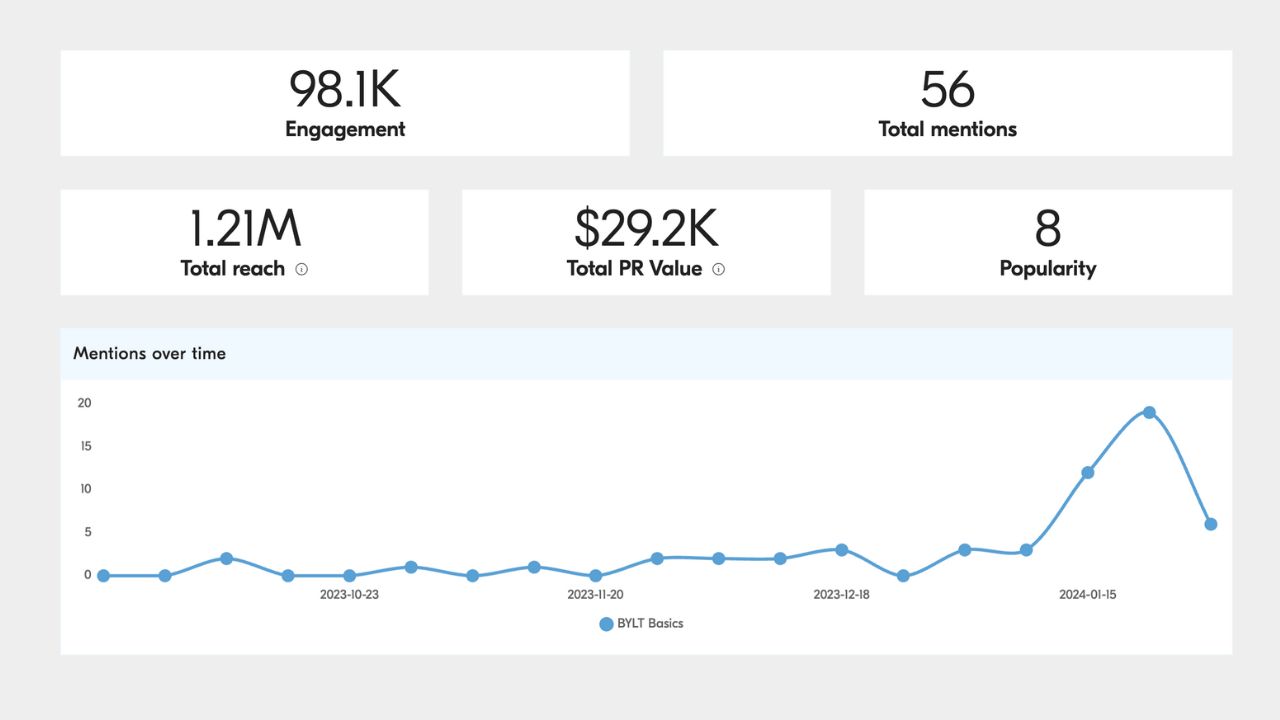
Talkwalker Social Listening Software Apps
Talkwalker is a social listening tool with a built-in, ready-to-use social media command center. It’s an intuitive platform that makes it easy to manage your brand online and across multiple social media channels. They also provide free social media monitoring but only seven days’ worth of data. In 2021, Talkwalker acquired Discover.ai, augmenting its existing Consumer Intelligence Acceleration platform and providing cultural and consumer insights.
The platform combines machine learning and human insights to help you dig deeper into human behavior and drivers and extract actionable insights from social media content and other platforms. The cultural data combined with consumer insight can help provide context into how your brand is perceived on the social web.
Read from several Talkwalker case studies to learn more about their capabilities and how they are helping brands solve real-world business problems.
Here are the key features of Talkwalker:
Data Collection
- Collects data from over 150 million websites, encompassing more than 30 social networks like Twitter, Instagram, Facebook, forums, blogs, and news sites.
- Offers full access to the Twitter firehose for comprehensive Twitter data analysis.
- Utilizes AI-powered image and video recognition technology to analyze visual content.
Analysis
- Conducts sentiment analysis in over 127 languages.
- Features trend analysis with a unique Trending Score to identify emerging patterns.
- The Virality Map tool illustrates how trends and topics spread online.
Monitoring & Alerting
- Provides alerts for brand mentions, emerging trends, spikes in volume, and potential issues.
- Includes customized dashboards for crisis management.
- Employs smart spike analysis for advanced detection of issues.
Reporting & Visualization
- Offers interactive dashboards and visualizations for detailed data analysis.
- Enables sharing of reports and insights across different teams within an organization.
Competitive Intelligence
- Tracks and analyzes competitors’ social media activities.
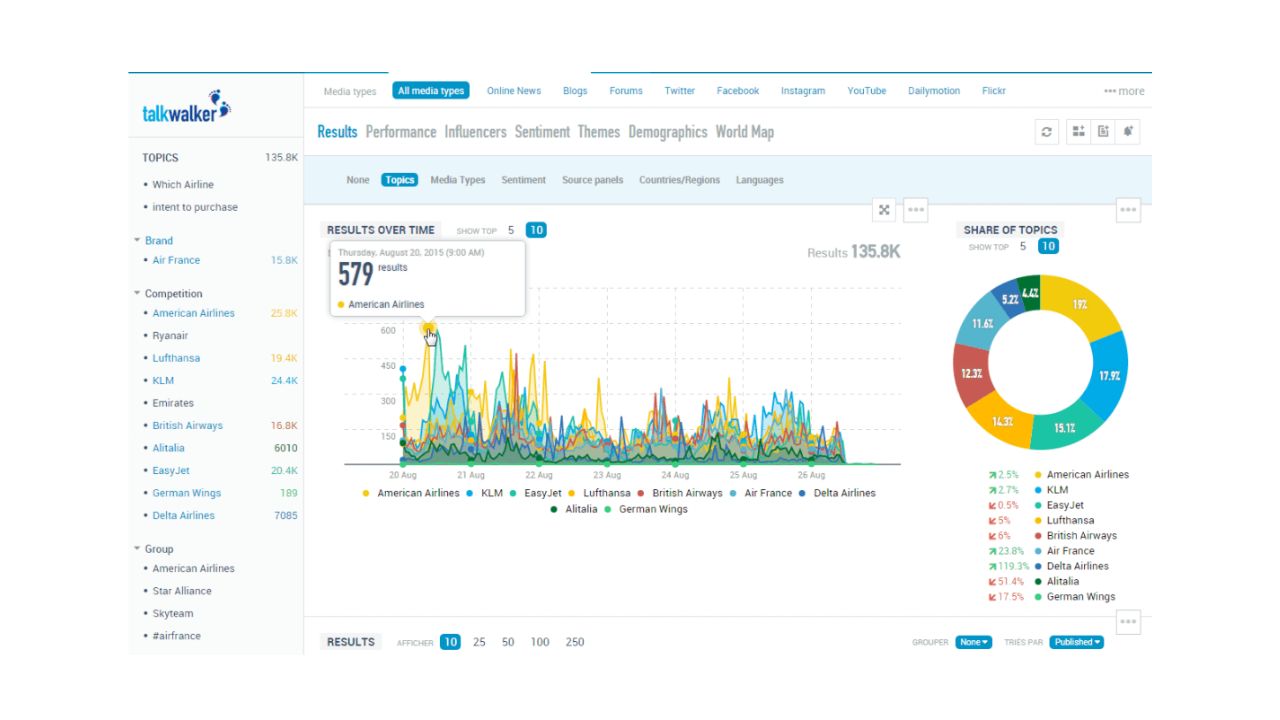
Brandwatch Social Listening Tool
Brandwatch Consumer Research is a tool to track, analyze, and understand social media conversations. It provides insights into what people say about a brand or topic, the sources, mention volume, and demographic data like age, gender, and location. You can also monitor and analyze news coverage and content from forums like Reddit.
Brandwatch Consumer Research also offers sentiment analysis, where you can identify negative sentiment and take action to improve your company’s brand reputation. In addition, the platform provides competitive intelligence, allowing you to track your social media performance against competitors. Finally, the launch of Brandwatch Audiences completely elevated their product offering, allowing you to build specific audiences and listen to their conversations on social media.
Here are the key features of Brandwatch:
Data Collection
- Collects data from over 100 million online sources, including social media, blogs, forums, news sites, etc.
- Access to historical data going back to 2008.
- Collects data in multiple languages.
- Data upload API to ingest enterprise data like surveys, support tickets, etc.
Analysis
- Sentiment analysis, entity extraction, image analysis, etc, using AI/ML.
- Ability to train custom classifiers using machine learning.
- Summarize conversations into themes using AI assistant Iris.
Monitoring & Alerting
- Create custom queries and get alerts on trends, sentiment, volume changes, etc.
- Monitor specific social media accounts, hashtags, competitors, etc.
- Get alerts on negative brand mentions.
Reporting & Visualization
- Variety of interactive dashboards and visualizations.
- Benchmarking against competitors.
- Share reports and insights across the organization.
Integrations
- APIs for integration with other marketing/sales tools.
- Integrates with social media management tools like Hootsuite.
Competitive Intelligence
- Track competitors’ social media activity.
- Analyze the competitive landscape and identify opportunities.
Brandwatch appears to be the leader in market share, but several Brandwatch alternatives are below. You can also take a peek at some of Brandwatch’s case studies.
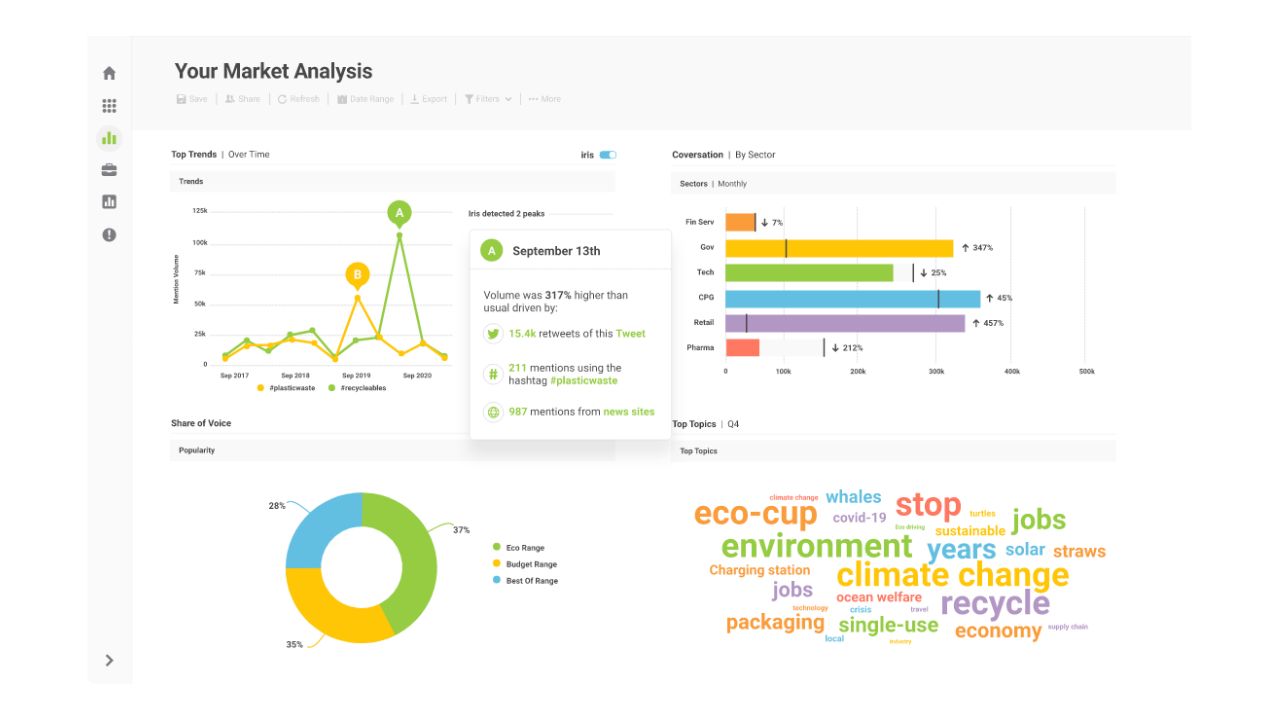
YouScan Social Listening Software
YouScan is a social media monitoring app that excels in image recognition capabilities. You can learn about their basic demographics and interests with their audience insights.
Also, you can evaluate sponsorship activities by analyzing branded social media posts, mentions, and user-generated content. YouScan’s social media monitoring tool is exceptional for supporting large social media marketing campaigns and excels for consumer brands with visible logos. You can attend one of YouScan’s webinars to learn more about the platform.
Here are the key features of YouScan:
Data Collection
- Gathers information from various social media platforms, including Instagram, Twitter, Facebook, YouTube, and TikTok.
- Possesses a vast repository of over 500 billion historical social media posts.
- Employs advanced AI for image recognition to analyze visual content on social media.
Analysis
- Provides sentiment analysis, identifies trends, and clusters topics.
- Features the Insights Copilot, an AI-driven tool for uncovering new insights.
- Capable of analyzing images to discern demographics, interests, and occupations.
Monitoring & Alerting
- Allows the creation of custom queries with alerts for trends and changes in sentiment.
- Enables monitoring of specific social media accounts, hashtags, and competitors.
Reporting & Visualization
- Offers interactive dashboards and visualization tools.
- Includes recently added customizable dashboards for tailored reporting.
- Facilitates sharing of reports within organizations.
Integrations
- Integrates seamlessly with CRM systems, helpdesk platforms, and messaging apps.
- Aids in identifying influencers and synchronizing data with CRM systems.
Competitive Intelligence
- Tracks and analyzes competitors’ social media activities.
- Benchmarks performance against industry competitors.
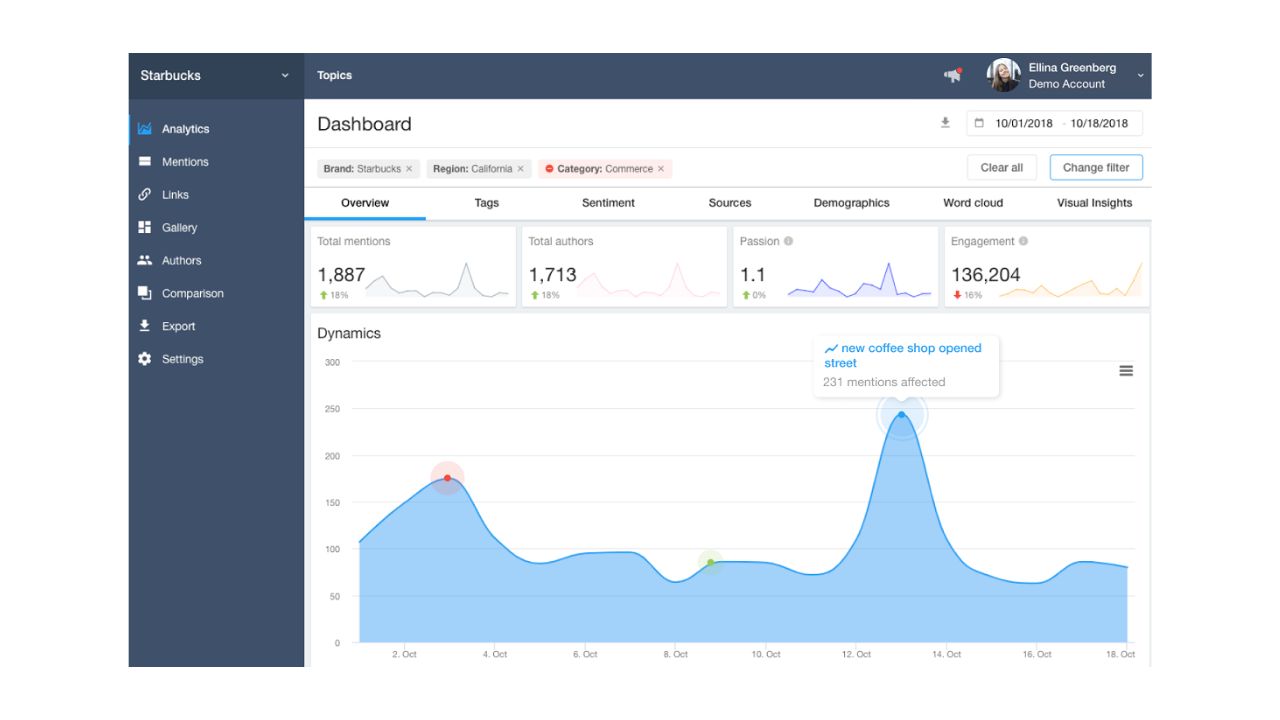
Synthesio Social Monitoring Tool
Synthesio’s Social Intelligence Suite is the only platform owned by a market research firm. Ipsos acquired them in 2018. Synthesio provides social listening dashboards and social media command centers for data visualizations and monitoring of real-time trends, events, and conversations.
In 2020, they launched Profiler, an audience management feature within their social media monitoring tool. They collect the audience data from Facebook and collect and analyze consumers’ behavior online. They also provide Topic Modeling, which categorizes millions of social media conversations into different themes that wouldn’t be obvious without such analysis. You can learn more by reading Synthesio’s case studies.
Here are the key features of Synthesio:
Data Collection
- Synthesio aggregates data from over 100,000 online sources, including social media, news, blogs, and forums, covering 197 countries in over 80 languages.
- Provides access to historical social data.
- Offers custom sourcing to monitor sites most relevant to the user’s needs.
Analysis
- Features sentiment analysis, topic clustering, and trend analysis, all powered by machine learning.
- Includes tools like Signals for detecting trends and shifts in interests.
- Conducts audience analysis to understand demographic details and preferences.
Monitoring & Alerting
- Offers social listening dashboards for a comprehensive view of owned, paid, and earned media.
- Provides alerts for changes in volume, sentiment shifts, and emerging trends.
- Enables monitoring of brand reputation, competitors, and marketing campaigns.
Reporting & Visualization
- Interactive dashboards provide insights into engagement metrics, market share of voice, and more.
- Real-time display of mentions and metrics for up-to-the-minute data.
- Allows for sharing of reports across different teams and functional areas within an organization.
Integrations
- Offers APIs for integration with a variety of marketing, sales, and support tools.
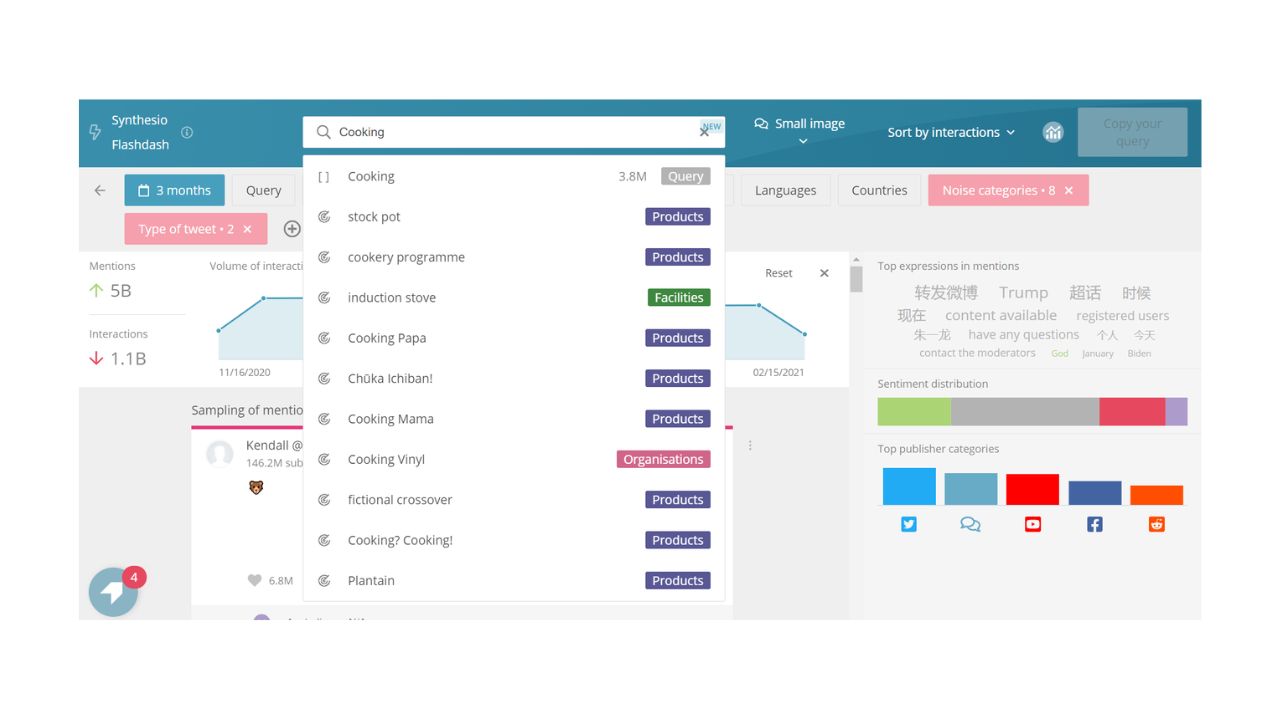
Pulsar Platform Social Monitoring
Sadly, Pulsar did not make it on Forrester’s Social Wave Report.
Pulsar has four parts of its social listening software–TRENDS, TRAC, CORE, and RESEARCH. Pulsar TRENDS is a data visualization of how social media trends spread across the digital ecosystem, locally and globally. Pulsar TRAC integrates advanced social listening with keyword, content tracking, and audience segmentation. Pulsar CORE tracks and manages the performance of your owned social media channels and websites. Finally, Pulsar RESEARCH consists of one-off industry insights.
Here are the key features of Synthesio:
Data Collection
- Gathers social media data from platforms like Twitter, Facebook, Instagram, YouTube, Reddit, and Tumblr.
- Also sources data from news sites, blogs, and forums.
- Provides access to historical social media data dating back to 2006.
Analysis
- Conducts sentiment, emotion, and image analysis using AI and machine learning techniques.
- Performs trend analysis to identify emerging topics and trends.
- Offers audience segmentation tools to understand different community dynamics.
Monitoring & Alerting
- Enables the creation of custom queries for alerts on trends, volume changes, and more.
- Facilitates monitoring of specific social media accounts, marketing campaigns, and competitors.
Reporting & Visualization
- Features interactive dashboards and visualization tools for data analysis.
- Allows sharing of reports across various teams and functions within an organization.
Integrations
- Provides APIs for integration with other marketing and analytics tools.
- Integrates with owned channel analytics from Google Analytics.
You can learn more from reading Pulsar’s case studies.
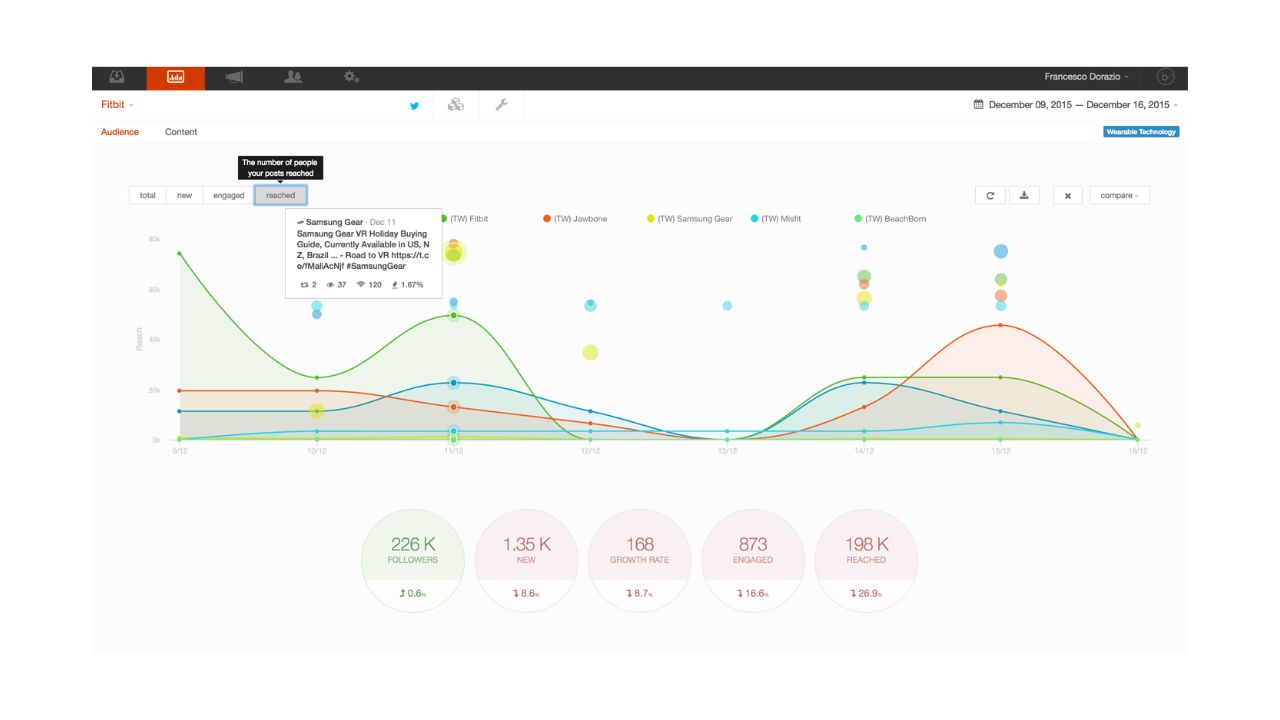
Digimind Social Listening Tool
Digimind is a social media monitoring tool integrating Facebook, Instagram, and LinkedIn post-level data. Onclusive acquired them in 2022.
Digimind’s platform pulls data from 800M online sources and uses AI-enabled social listening technology for tagging sentiment analysis and visual listening. They also provide multiple ways to visualize and export reports and integrate easily with Google Data Studio (now Looker).
Here are the key features of Digimind:
Data Collection
- Harvests data from over 850 million sources worldwide, including social media, news, blogs, forums, and reviews, covering more than 190 countries and 200 languages.
- Incorporates offline data sources such as TV, radio, and surveys.
- Provides access to historical social media data.
Analysis
- Utilizes AI for sentiment analysis, trend identification, and visual listening.
- The Top Reputation module offers insights into Google search behaviors and interests related to brands in real-time.
- Features smart tagging and clustering to efficiently summarize online conversations.
Monitoring & Alerting
- Enables the creation of alerts for brand mentions, emerging trends, and volume changes.
- Monitors brand reputation across various online platforms.
- Includes competitive intelligence features for tracking competitors’ activities.
Reporting & Visualization
- Offers interactive dashboards and visualizations for in-depth data analysis.
- Facilitates the sharing of reports and insights throughout an organization.
Integrations
- Provides APIs for integrating social data with other business applications.
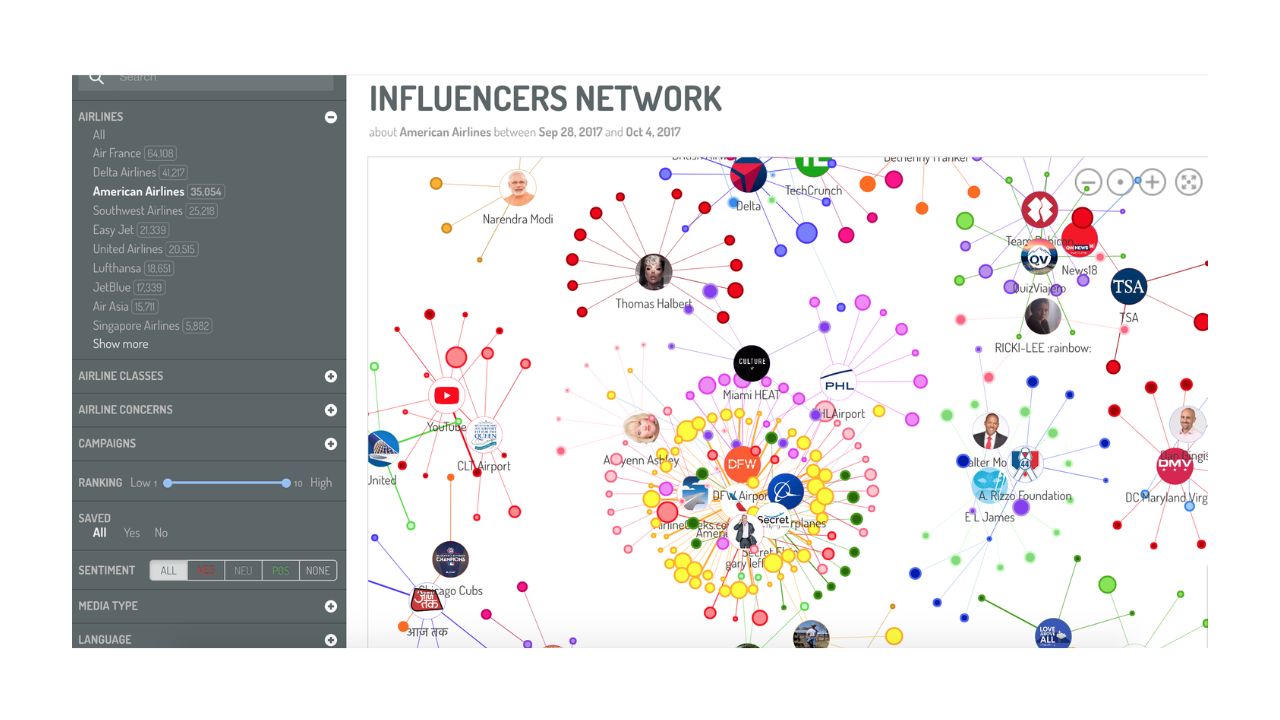
Infegy Atlas Social Listening Software
Infegy is an advanced social media listening tool led by text analytics and natural language processing (NLP).
They have also built pre-existing segments of various audiences, making it easy to segment and compare data. They provide multiple ways to analyze text data, sentiment, emotions, volume, reach, and engagement. In 2022, they launched a new capability that clusters all the content into themes, topics, and interconnected narratives.
Here are the key features of Infegy:
Data Collection
- Harvests data from over 850 million sources worldwide, including social media, news, blogs, forums, and reviews, covering more than 190 countries and 200 languages.
- Incorporates offline data sources such as TV, radio, and surveys.
- Provides access to historical social media data.
Analysis
- Utilizes AI for sentiment analysis, trend identification, and visual listening.
- The Top Reputation module offers insights into Google search behaviors and interests related to brands in real-time.
- Features smart tagging and clustering to efficiently summarize online conversations.
Monitoring & Alerting
- Enables the creation of alerts for brand mentions, emerging trends, and volume changes.
- Monitors brand reputation across various online platforms.
- Includes competitive intelligence features for tracking competitors’ activities.
Reporting & Visualization
- Offers interactive dashboards and visualizations for in-depth data analysis.
- Facilitates the sharing of reports and insights throughout an organization.
Integrations
- Provides APIs for integrating social data with other business applications.
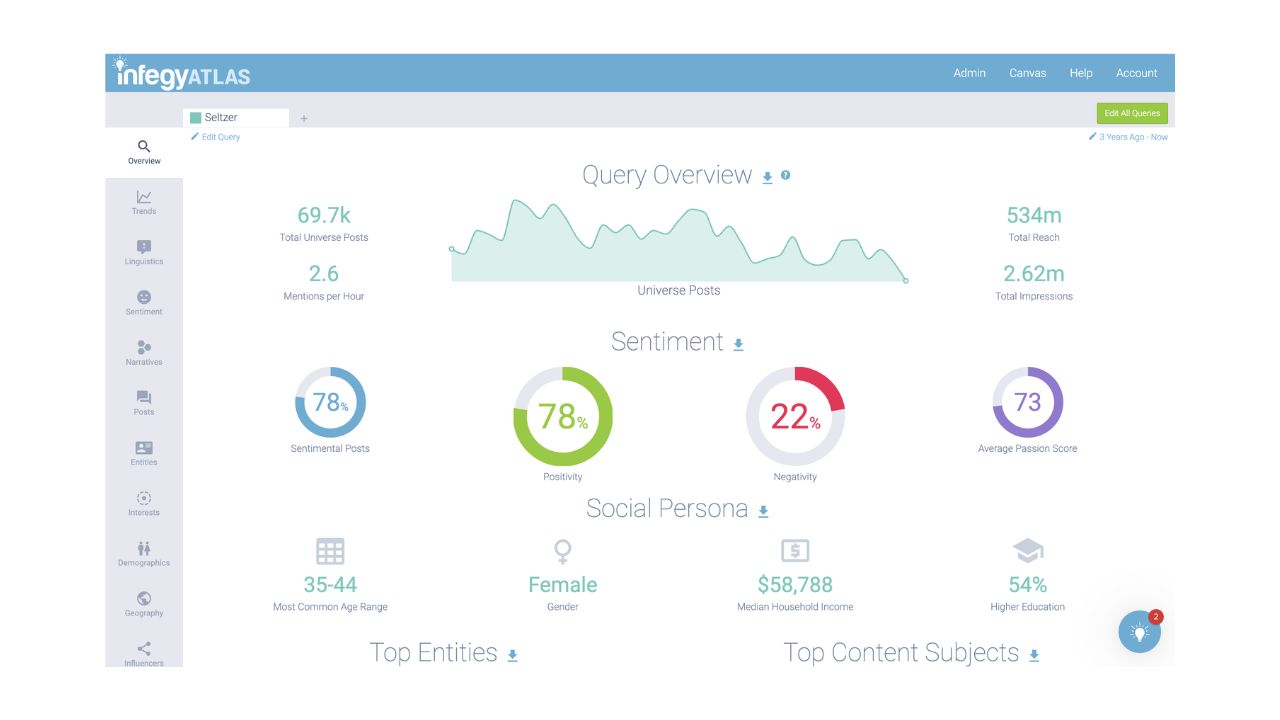
Netbase Quid Social Listening Platform
Netbase is an enterprise-level social media monitoring tool. In 2020, they merged with Quid, a text analytics company. In 2021, they acquired RivalIQ, a competitive social media analytics platform that tracks content performance across all social platforms.
NetBase can help you gain insights from content posted on all digital channels. Through its advanced Natural Language Processing (NLP) engine, the system can detect and measure the sentiment behind any text to uncover consumer attitudes, willingness to purchase, and unmet customer needs. They provide social listening dashboards with data visualizations in charts, graphs, heatmaps, and clusters. You can customize reports and send them to email accounts for easy access.
Netbase cam also helps you monitor images, track emerging trends, engage with influencers, and get real-time insights. In addition, you can learn more from reading Netbase Quid’s case studies.
Here are the key features of Netbase Quid:
Data Collection
- Harvests data from hundreds of millions of social media posts and a historical archive of over 100 billion posts across the social web.
- Collects content from platforms like Twitter, Facebook, Instagram, YouTube, as well as forums, blogs, and news sites.
- Capable of ingesting first-party data such as surveys and support tickets.
Analysis
- Offers sentiment, topic, and demographic analysis using natural language processing (NLP) and artificial intelligence (AI).
- Features a new AI Search tool, powered by ChatGPT, to extract insights.
- AI Summary function distills key narratives and conversations into concise summaries.
Monitoring & Alerting
- Allows for the creation of custom queries and provides alerts on brand mentions, trends, and changes in volume.
- Monitors brand reputation and conducts competitor tracking.
Reporting & Visualization
- Interactive dashboards and visualizations facilitate in-depth data analysis.
- Supports exporting reports in formats like PPT, CSV, and PNG.
- Enables sharing of reports and insights across an organization.
Integrations
- Integrates with social media management platforms like Hootsuite.
- Offers APIs for integrating social data into various business systems.
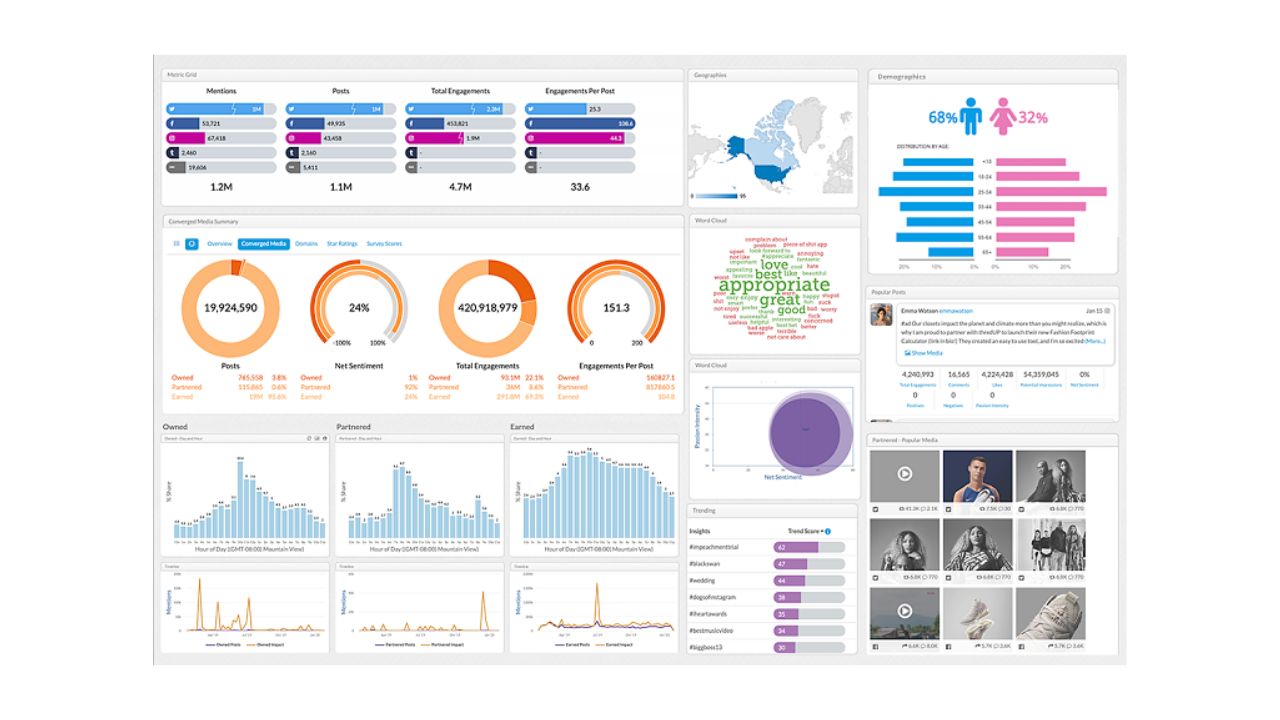
Zignal Labs Social Media Monitoring Software
Zignal’s Narrative Intelligence Cloud can detect and assess topics and narratives, whether positive or negative. It’s known in the market to have the most robust reputation analytics engine that can detect and mitigate narrative threats or capitalize on narrative opportunities in real time.
Zignal is best known for helping brand managers and PR pros navigate crises on social media and within media coverage.
Here are the key features of Zignal Labs:
Data Collection
- Gathers information from more than 50 million online sources, including social media, news, blogs, and forums across the web.
- Processes over 8 billion new data points each day and provides access to a historical database of over 143 billion documents.
Analysis
- Employs AI and machine learning for advanced analytics like topic extraction, entity extraction, narrative analysis, network analysis, and geospatial analysis.
- Enhances data with over 120 million enrichments every hour.
Monitoring & Alerting
- Enables the creation of alerts for brand mentions, emerging trends, volume changes, and narrative shifts.
- Offers tools to monitor brand reputation and track competitors’ activities.
Reporting & Visualization
- Provides over 80 customizable data visualizations and dashboards for in-depth analysis.
- Allows sharing of reports and insights throughout an organization.
Integrations
- Offers APIs for integrating the gathered intelligence into various other business systems.
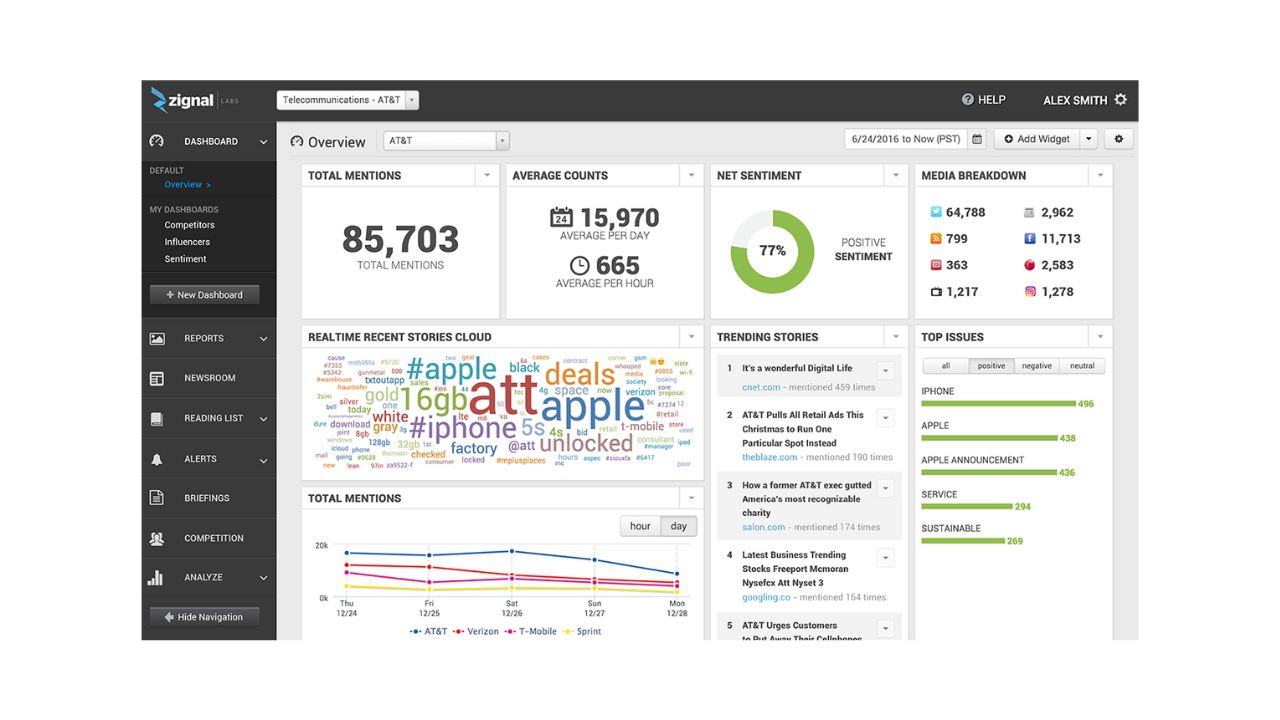
Linkfluence Social Media Monitoring
Meltwater acquired Linkfluence in 2021.
Linkfluence is a social media listening platform providing industry and brand insights. With their AI-powered consumer insights platform Radarly, you can mine data from across the web to capture real-time conversations from social media and forums and provides a detailed view into public perception. In addition, you can track the engagement rate around your campaigns to evaluate their impact on customers.
You can use advanced analytics and social media listening tools like sentiment analysis, trend discovery, and audience profiling to understand when certain topics are discussed and in what context. Finally, Linkfluence even provides social ROI calculations to get a clear view of your digital campaigns’ performance. Read Linkfluence’s case studies to get a complete view of their capabilities.
Here are the key features of Linkfluence:
Data Collection
- Amasses data from over 300 million online sources, including social media, news, blogs, and forums across the web.
- Processes more than 1.5 billion posts daily, covering over 70 languages.
- Employs AI-powered image recognition for analyzing visual content.
Analysis
- Provides sentiment, topic, and trend analysis.
- Offers audience analysis to discern demographics and interests.
- Features powerful filtering options to focus on relevant conversations.
Monitoring & Alerting
- Enables creation of alerts for brand mentions, emerging trends, and changes in volume.
- Facilitates monitoring of specific accounts, hashtags, and competitors.
Reporting & Visualization
- Presents interactive dashboards and visualizations for in-depth data analysis.
- Allows sharing of reports and insights throughout an organization.
Competitive Intelligence
- Tracks competitors’ social media activities.
- Benchmarks performance against industry competitors.
Integrations
- Offers APIs for integrating social data into various business systems.
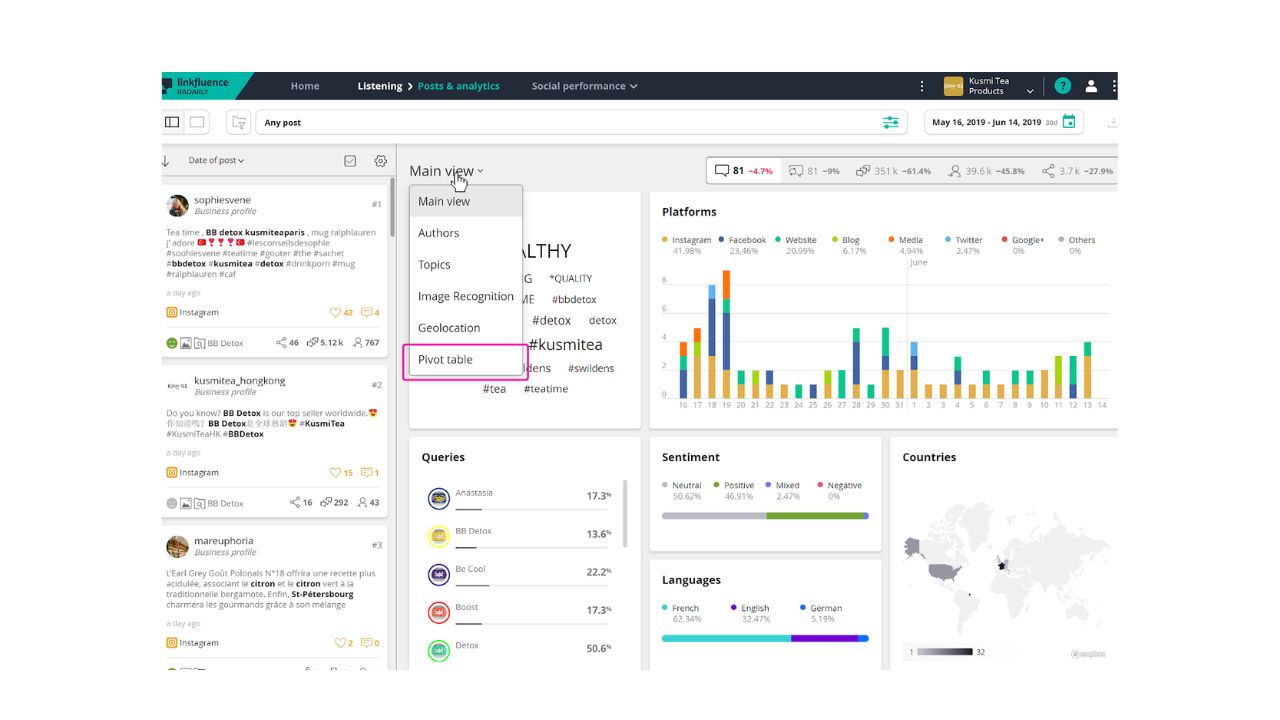
Note: It’s critical to ensure that when hiring a social media or PR agency, they have the skills and expertise for social media monitoring work and analysis. They should have access to a complete social channel monitoring tech stack, which includes the platforms listed above.
FAQ
Social media monitoring is the marketing practice of using software to track conversations and mentions on social media. Other use cases include measuring share of voice, social analytics, reporting & measurement, and managing social customer care.
All social listening platforms work the same way. You start with identifying the most relevant keywords to your products, services, and business. Once you’ve identified the right keywords, you add them to the social media listening platform using a form of Boolean Logic. The social monitoring tool collects mentions from each source and then displays them using various data visualizations.
Setting up social media listening involves identifying your goals, such as managing your brand reputation, understanding your audience, providing better customer service, or gathering competitive intelligence. You then choose relevant keywords, phrases, brand names, or hashtags you want to monitor. The next step is to select a social media listening tool that suits your needs. Once you’ve set up the tool with your chosen keywords, you can start monitoring and analyzing the data it collects.
Social media monitoring can be used for real-time audience listening and customer engagement, listening to customer feedback, consolidating insights, and taking action. It can also be used for audience analysis and media intelligence.
This is more about semantics, but social listening and monitoring mean the same thing. The definition of monitoring is to “observe and check the progress or quality of (something) over a date range.” In this case, “something” refers to social media and the conversations happening online and on various digital channels.
Some of the leading tools include Brandwatch, YouScan, Synthesio, Pulsar, Digimind, Infegy, Netbase, Zignal, Talkwalker, and Linkfluence.
Social media monitoring tools can help businesses understand their audience, track the performance of their social media campaigns, manage their online reputation, and respond quickly to customer queries or complaints. They can also provide valuable insights for market research and competitive analysis.
The “best” tool can vary depending on your specific needs. Still, many of the top social media monitoring tools, like Hootsuite, Sprout Social, and Talkwalker, offer robust features for monitoring Facebook.
Social media monitoring tools allow you to monitor public posts and conversations about your brand or chosen keywords. However, they do not allow you to monitor private conversations or violate user privacy.
A social media monitoring tool can save time and provide more comprehensive and accurate results than manual monitoring. These tools can track conversations across multiple platforms and provide analytics that would be difficult to compile manually.
Monitoring social media can help you understand your audience, track the performance of your social media campaigns, manage your online reputation, respond quickly to customer queries or complaints, and gain valuable insights for market research and competitive analysis.
While social media monitoring tools offer many benefits, they may not capture all online conversations about your brand, especially if those conversations happen in private groups or on platforms not covered by the tool. They may also have limitations regarding sentiment analysis and identifying sarcasm or nuanced language. Additionally, they require a strategic approach to keyword selection to ensure you’re capturing the most relevant conversations.
An example of social listening could be a business monitoring mentions of its brand and products across social media platforms. If they notice a surge in negative comments about a particular product, they can quickly identify the issue, address it, and communicate their actions to their audience. This is a way of managing their online reputation effectively.
